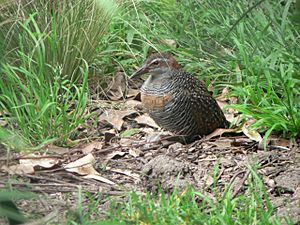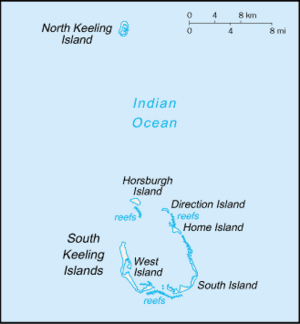Cocos buff-banded rail facts for kids
Quick facts for kids Cocos buff-banded rail |
|
|---|---|
 |
|
| Conservation status | |
| Scientific classification |
|
| Kingdom: | Animalia |
| Phylum: | Chordata |
| Class: | Aves |
| Order: | Gruiformes |
| Family: | Rallidae |
| Genus: | Gallirallus |
| Species: | |
| Subspecies: |
G. p. andrewsi
|
| Trinomial name | |
| Gallirallus philippensis andrewsi (Mathews, 1911)
|
|
The Cocos buff-banded rail is a special kind of bird found only on the Cocos (Keeling) Islands. Its scientific name is Gallirallus philippensis andrewsi. This bird is a subspecies of the more common buff-banded rail. It lives in the central-eastern Indian Ocean, which is an Australian territory.
The people who live on the Cocos (Keeling) Islands are called Cocos Malays. They have a special name for this bird: ayam hutan. This means "chicken of the forest."
Where Does It Live?
Today, the Cocos buff-banded rail mostly lives on a small island called North Keeling Island. This island is only about 1.2 square kilometers (less than half a square mile) in size.
Long ago, these birds were common on the other 26 islands of the Cocos (Keeling) Islands, known as the Southern Atoll. But now, it's very rare to see them there. Scientists think they have mostly disappeared from those islands. Sometimes, a bird might fly over from North Keeling, but they don't stay and start new families.
On North Keeling Island, these rails live everywhere they can find ground. This includes the edges of the lagoon and under the trees. They like to hide in the plants under Pisonia trees and coconut palms.
Scientists believe there are about 850 to 1000 of these birds on North Keeling Island. This means there are about 7 to 8 birds in every hectare (about 2.5 acres) of land.
What Does It Eat?
The Cocos buff-banded rail is an omnivore. This means it eats both plants and animals. It looks for food all over the island, even along the muddy edges of the central lagoon.
Its diet includes many things:
- Small crustaceans (like crabs)
- Molluscs (like snails)
- Insects
- Worms
- Seeds and fruits
- Eggs
- Carrion (dead animals)
They also act like scavengers, eating leftover food from the seabird nests.
Protecting the Cocos Buff-banded Rail
The Cocos buff-banded rail is an endangered bird. This means it is at high risk of disappearing forever.
On the Southern Atoll islands, these birds likely disappeared because their homes were destroyed. Also, new animals like feral cats and black rats were brought to the islands. These animals hunted the rails. Even humans and other birds like junglefowl caused problems.
On North Keeling Island, where most of the rails live, there are still dangers. One threat is the introduced yellow crazy ant. There's also a risk that new animals that hunt birds could accidentally arrive. Strong storms like cyclones and tsunamis can also harm the birds and their homes.
North Keeling Island is now a protected area called the Pulu Keeling National Park. Because the island is so small, scientists are thinking about moving some rails to other southern islands. This would only happen after making sure those islands are safe for the birds. This way, if something bad happens on North Keeling, the birds will still have other places to live.
The Australian government lists the Cocos buff-banded rail as endangered under a law called the Environment Protection and Biodiversity Conservation Act 1999. This law helps protect animals and plants that are in danger.
Because it's the only bird found only on the Cocos (Keeling) Islands, the Cocos buff-banded rail has often been shown on postage stamps from the islands.



